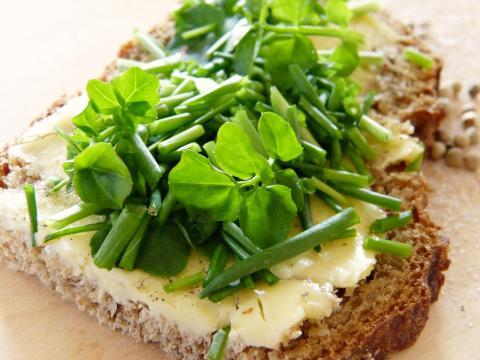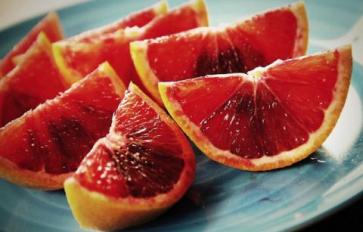
Now that you know your spring veggies from A to K, let’s carry on with the alphabetical health from L onwards…(Excuse us the missing alphabets, we couldn’t find a veggie to match!)
If you’re looking to get yourself—and your family—eating healthier, spring veggies are a great place to start because of the intense diversity of a spring larder!
L is for Leeks
Leeks are from the onion-garlic family but have a very mild flavor and taste almost sweet. Most people serve leeks as a side dish, sautéed or caramelized a tad. They can be added raw in salads as well…They are rich in antioxidants and like onions and garlic, they add fiber and heart health to your diet. They are also a well-known anti-cancer veggie like their cousins, onion and garlic.
M is for Morels & Mustard Greens
So morels are antioxidant rockstars and also burst with all the goodness of vitamin D—they pop their heads out only in the warmth and moistness of spring and taste good as long as they are washed and cooked well. You can add them to curries and stir-frys and even layer them in sandwiches since they have a rather meaty flavor. Mustard greens have all the goodness of green veggies—rich in iron, calcium, and other phytophenols, they add great taste and health to your palate.
N is for Nettle & New Potatoes
Stinging nettle is a great source of iron, vitamin A (retinol), B vitamins, vitamin C (ascorbic acid), and vitamin K. Plus, it is rich in calcium, silica, carotene, magnesium, chromium, potassium, and zinc. So before you throw it out as a weed, remember that it’s actually a great food source that can be served up as side greens. Once cooked and washed, the sting vanishes and all that remains are the health benefits. With low-carb diets, potatoes often get a bad rap but the fact remains, they are very, very healthy—and new potatoes with thin skins are especially tasty as well! With no fat, sodium, or cholesterol, nearly half the daily value of vitamin C, more potassium than a banana, and plenty of vitamin B6, fiber, magnesium, and antioxidants, tossing new potatoes with herbs for a side dish makes for a healthy spring treat.
O is for Onions (Spring)
Yup, as Tinkerbell movies have clearly shown, it ain’t spring until the spring onions sprout! So use your spring onions raw or cooked, as a garnish or as a caramelized side dish—the way you like. They taste great any which way. Try making a new potato and spring onion omelet and enjoy the flavors of spring at its best. They are rich in vitamins and minerals and also aid in controlling blood sugar levels.
P is for Peas
Anyone who has picked fresh peas off a vine knows the lure of those crunchy veggies that don’t quite make it back to the kitchen—except that you really have to watch out for curled up caterpillars while shelling them. And in case you have chipmunks around, you won’t be getting any peas to eat, only the shells! You can eat them raw, cook them in risottos and pasta, add them to curries and soups, crush them into pesto and spreads and just enjoy them in any form whatsoever. They are a very healthy vegetable, rich in vitamin K, manganese, fiber, vitamin B1, copper, vitamin C, phosphorus, and folate. Other nutritional benefits include vitamin B6, niacin, vitamin B2, molybdenum, zinc, protein, magnesium, iron, potassium, and choline! P for peas, p for powerhouse!
R is for Rhubarb, Radicchios, & Ramps
What’s spring without a good rhubarb pie, jam, or even pickle? Packed with fiber, protein, vitamin C, vitamin K, B complex vitamins, calcium, potassium, manganese, and magnesium, rhubarb stalks make for tasty spring sweet things! Radicchio is what grocers loosely call a purple cabbage. A spring veggie, it makes for a great salad with balsamic dressing but can be roasted, kimchi-d or even sautéed as a healthy side dish brimming with fiber, vitamins, minerals, antioxidants, vitamin K, vitamin C, folate, and copper. Ramps are from the onion family and rather elusively found for just a few weeks—and they grow wild so they often demand a steep price at the supermarket. They have all the properties of the garlic-onion family and can be used as a great side dish—even fried as fritters!
S is for Spring Greens
Kale, chard, spinach, bok choy, beet greens, mustard greens—the list of leaves to chomp in spring is endlessly healthy and tasty. They are great in salads (tender leaves) or stir-frys (crispy spinach tastes heavenly), can be chopped up and turned into fritters, and can even be pureed into sauces, curries, and pesto! They brim with all the goodness of a plant-based diet—minerals, vitamins, and antioxidants and all that you need to grow strong and live well! Many of the greens are also rich sources of omega-3 & 6 fatty acids so think of greens as brain food!
T is for Turnips
Okay, a bit of a cheat here. Depending on when you planted your turnips, they’re both a fall and a spring vegetable. Turnips have a slight heat to them and can be eaten raw in salads, pickled for some probiotic health, or boiled and mashed into a rather different version of mashed potatoes, or rather, mashed turnips. The greens taste a little like mustard greens in that they have a mild kick to them, and make for a great addition to soups, curries, pastas, or even a good pesto. Turnips fairly burst with vitamins A, C, B, E & K, and folate. Plus, they are rich in minerals like manganese, fiber, potassium, magnesium, iron, calcium and copper. They are also a decent plant-based source ofomega-3 fatty acids.
V is for Vidalia Onions
Why are we mentioning Vidalia onions specifically? Well, because they are the sweetest cultivar of the onion family and taste great in salads as well as in stuffing and curries. While you do get them year-round, spring is when you get the very first harvest—and nothing tastes sweeter than caramelized Vidalia rings served with pulled pork or spring greens! And yes, sweet or not, Vidalia onions offer plenty health benefits as does all of the allium (onions and garlic) family.
W is for Watercress
So watercress is a weed, with more calcium than milk, and is great for you all through the year. But the spring harvest of watercress is when you get the best taste and the best nutrition from it, so it’s best to add it to your salads and garnish your pasta, soups, and even casseroles with it. Other than calcium, watercress is also high in protein, folate, pantothenic acid, and copper. It is also rich in vitamins A, B6, C, E, and K, as well as thiamin, riboflavin, magnesium, phosphorus, potassium, and manganese.
Y is for Yolks
With Easter around, eggs get a decent rap in spring. And whether you boil them, fry them, whip them into omelets, poach them, or even pickle them, eggs are very, very healthy for you. And stop throwing that yolk away—dietitians have proven it to be a source of good fats over and over again. Maybe it’s time we really listen up! A very good source of inexpensive, high-quality protein, an egg-breakfast keeps you full for longer and prevents you from any unhealthy snacking. Eggs also contain omega-3 fatty acids and vitamins A, B, E & D, as well as minerals such as calcium, zinc, iron, and copper. They also contain lecithin, plus are considered a complete source of protein as they contain all nine essential amino acids—including the ones we cannot make in our bodies and must get from external food sources.
So that’s it for now—the A to Z of mostly vegetarian spring larder. We hope we haven’t missed out a veggie and would be happy to hear from you in the feedback section if we have. Meanwhile, happy spring eating








